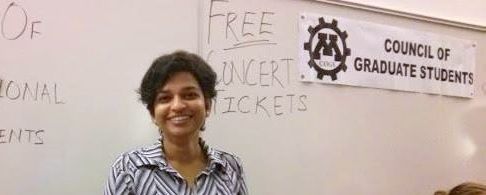
Navigating new environments is a skill Sumitra Ramachandran mastered as a young girl in India. The daughter of an army officer, her family moved frequently within the country, fortifying Ramachandran’s ability to adapt to and embrace change. These early experiences embedded a curiosity and resourcefulness that’s reflected in her professional journey of discovery, her support of other international students and her current academic pursuit.
After earning a Bachelor of Arts in English Literature and a Postgraduate Diploma in Journalism, Ramachandran began working as a picture researcher for a stock photography company in India. The position involved fulfilling digital imaging requests for clients around the world and required sensitivity to the cultural context of the images. She was intrigued with identifying and understanding the subtle, visual differences among cultures, excelling at the challenge and working her way up to team leader. “But, there was no further growth so I decided to explore freelance writing,” she recalls.
As a freelance writer and editor, she began creating advertising and marketing copy for print ads and websites. She secured a role as an advertising agency creative director while her freelance assignments grew. She began consulting with technology companies, serving as a voice artist for Apple apps, developing scripts for story apps, and writing technical documentation for gaming sector clients. This work sparked another transition point in Ramachandran’s career path. “Technical writing seemed more ethical to me,” she says. “It’s much easier on the conscience.”
Interested in pursuing technical writing further, Ramachandran sought formal training but couldn’t find a program in India at the time. Then, while visiting family in Minnesota, Ramachandran learned about the Technical Writing and Communication Certificate in the Department of Writing Studies at the University of Minnesota. She initially enrolled in the certificate program, but transferred to the MS program in the spring.
As a new student in a new country, Ramachandran’s open, outgoing nature led her to pursue numerous student activities including the Council of Graduate Students (COGS), where she served a term as the Executive Vice President. Ramachandran is also the founder of CIGS, the Council of International Graduate Students, a student-created group that helps acclimate international graduate students to the University while providing representation and advocacy for issues international graduate students face as a whole.
Through Ramachandran’s involvement with COGS and CIGS, she recognized a gap in connecting students to the resources within large institutions, and a need for nurturing students’ multicultural skills to increase academic success and support efforts in the professional world. “The ability to work within multicultural groups is a huge asset to students when applying for jobs,” Ramachandran says.
With this awareness, when a friend suggested the MA in Multicultural College Teaching and Learning in the Department of Postsecondary Teaching and Learning, Ramachandran knew it was her next step. “I realized their impact and that I could be a part of it,” she says.
From firsthand experiences, Ramachandran knows education changes things: opening up new possibilities and opportunities. And, she believes: “Communication is the gateway to educational access.” Upon graduation in Spring 2016, Ramachandran will be well positioned to negotiate differences in learning and institutional barriers in support of international and first-generation college students. By combining her experiences, expertise and education, students will benefit from Ramachandran’s navigational aptitude as they chart their own academic and professional paths.



